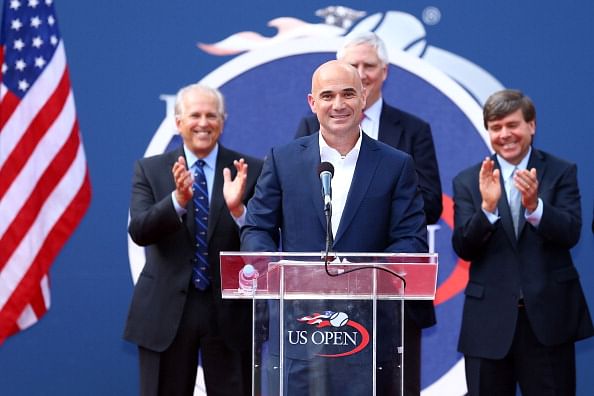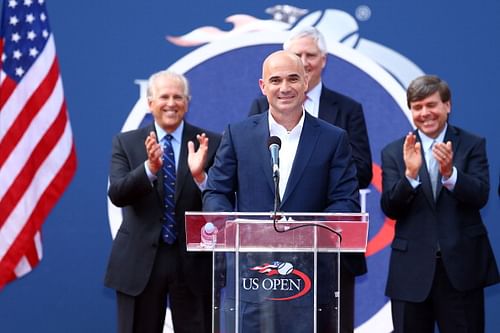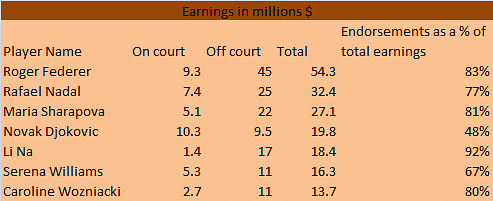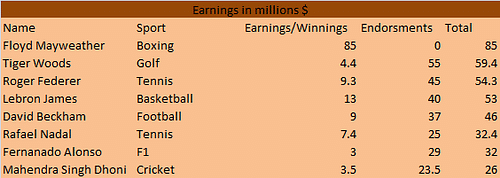
The economics of tennis

NEW YORK, NY – SEPTEMBER 09: Andre Agassi speaks to the crowd during a ceremony honouring his career prior to the women’s singles final match between Serena Williams of the United States and Victoria Azarenka of Belarus during Day Fourteen of the 2012 US Open at USTA Billie Jean King National Tennis Center on September 9, 2012 in the Flushing neighbourhood of the Queens borough of New York City.
I recently read Andre Agassi‘s autobiography ‘Open’. Agassi’s migrant family was by no means wealthy, but his father made sure Agassi got a lot of court time to practice and play through indirect means. Growing up, I remember my parents mentioning that tennis is a rich people’s sport, given the high costs of the equipment, maintenance costs and of course the cost of getting time on courts. Even when one watches movies, it is hard not to miss the status and class associated with the game of tennis. The whole tennis club culture and patronizing by royals has lent a sort of image to the game – that it is perhaps meant for the upper echelons of the society.
No wonder then that in most developing and third world countries, tennis is perhaps not a sport many people actually play. There are exceptions though. Apart from Agassi, the Williams sisters are a wonderful example of people who worked harder than others to play the sport. Even the Serbian brigade of tennis players that includes Novak Djokovic, Ana Ivanovic etc have spoken about the struggles of keeping their tennis dreams alive and playing in former swimming pools. Tennis may be an expensive sport to learn and play, but it is also one of the most rewarding sports in terms of monetary compensation if, and I reiterate, if, you make it to the later stages of tournaments.
Take a look at what the four grand slams pay the men’s and women’s winners
Wimbledon - $1.8 million
Australian Open - $2.36 million
French Open - $1.6 million
U.S. Open - $1.8 million
These numbers might paint a very rosy picture, but the truth of the matter is that tennis is not just about the top 10 players or the Grand Slams, but for up and coming players or players in the top 100 as well. The average money earned is not too high though, and the difference in the average salaries of the top 20 players compared to those in the ranks 50-100 is pretty huge, although the expenses are more or less the same. It is this difference that prompted former player Pat Cash to state that tennis is the toughest sport to play in the world, not just because of the sheer physicality and competitiveness, but also because sustaining oneself on tour is very expensive.
Unlike other popular team sports such as football or cricket, there are lot of personal expenses in tennis. Travelling costs are the biggest burden on the pay-cheque for most tennis players. Although most tournaments pay for a player’s accommodation, food and other hospitality, the airfare for the player and his entourage which these days consists of the coach, physical fitness trainer, mental fitness trainer, a boyfriend/girlfriend/spouse, agents and the like has to be borne by the player himself. Add to it the enormous amount of travelling the players have to do going to places around the globe, and this leads to a significant depletion of money.
Now, the price of tickets is the same for any player irrespective of his or her rank and hence, for players ranked low, it becomes difficult to fund their tennis unless they have generous sponsors and/or endorsement deals. Here is a look at players’ earnings purely from their tennis commitments.


Some might argue that this is a very fair statistic, since the most talented players are earning the most. True, tennis does reward its most talented players heavily, but without the top 50 and top 100 players who work equally hard if not more, the whole structure of the tennis establishment would fail and this massive disparity in earnings coupled with the expenses is leading to dissent. Another interesting fact to observe is that the money earned by female tennis players is on an average lower than their male counterparts.
This is because apart from the top ten tournaments, most other tournaments pay less to the women. This has been a long-standing debate over whether women should be paid on par with men or not. People against equal pay argue that men play best of five sets while women play best of three. There is a glaring hole in this logic. The best of five sets happen at the grand slams and there the pay is equal. At most other tournaments even the men play best of three sets and it is here that the pay is not equal.
Isn’t this paradoxical? If the argument is based on popularity and television ratings, even then it seems flawed because more people tune in to watch the US Open women’s final than the men’s and hence, the women’s final is played on Saturday night. Billie Jean King, by the same line of reasoning said,
“Entertainers don’t get paid by the hour. They get paid, period. If Elton John does a concert, it could last one hour or four hours. It’s a done deal.”
Thus, although the grand slams pay equally to the winners, the overall purse of money for the women’s draw is smaller compared to the men’s. There have been several arguments on this issue, and there has been significant amount of pressure on tournament organizers to re look their economics.
Moving on from the men vs women debate, another important event that happened earlier this year regarding the pays at tournaments was at the US Open where the players council, led by Roger Federer, pressed for an increase in pay at the grand slams, especially for players who lose in the earlier rounds. Most other ATP events, pay 20 to 30% of their revenues to the players. The Grand Slams pay lesser. The players want at least 12 to 13% of the grand slam revenues as payments to players but the grand slam organizers are trying hard to negotiate.
Their point of reasoning is that since grand slams pay equal prize money to men and women, the overall share of prize money as a percentage of the revenue would shoot up to 25% and such a sharp rise in just one year would not make business sense. This would mean convincing all stakeholders, including sponsors.
But there has been unprecedented support from players, both current and former, with respect to this move by the players. Pete Sampras also stated that the Grand Slams make tons of money because of the players and have gotten away by not paying them their dues vis-a-vis other tournaments under the blanket of their non-profit status and other charitable initiatives. Another positive is that there is unity among the players on both the men’s and women’s side regarding this issue. Why such hue and cry over money. Well, take a look at this article and things will come into perspective.
Another economic facet of tennis is endorsement/advertisement deals. Most of the top players and sometimes the not so top, but glamorous or good looking players (someone like Sharapova or Kournikova) make a majority of their money from sponsorship deals.

For the lower ranked players, the entire off-court earning part is almost negligible. Thus, the skewed pays and the ever increasing expenses coupled with the window of play time has brought the entire economics of playing tennis into the spotlight again. To add more dimensions to this discussion here is a snapshot of the world’s highest paid sports persons

Sports such as basketball, football and cricket are team sports and most expenses including travel are borne by the sponsors or the club or the country. Although golf is also an individual sport, the disparity in pay between the top and bottom of the pyramid is low because a majority of players in a golf tournament play till the last day. The ratio of endorsement money to actual earned money is alarming because it shows the extent to which sports persons depend on off court activities to fill their bank accounts (exception being Floyd Mayweather).
All said and done, tennis does pay good but is it good enough. After all it is not just about the Rogers and Nadals and Serenas. Tennis as a whole benefits because of the vast talent pool and the numerous number of players who work day in and day out.
Some sort of balance is thus required to reward not just talent but also hard work and dedication.